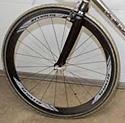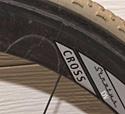
Recently on Cyclingnews.com |
On test: Reynolds Stratus cyclocross wheels, December 20, 2005
More tough mud-mashers
The cyclocross incarnation of Reynolds' mid-depth carbon fiber wheels uses a few more spokes to give it the strength for 'cross. Rob Karman finds it plenty tough enough but wishes for the holy grail of better braking.

|
After our recent review of the Zipp 303 cross wheels, competitor Reynolds Composites was quick to send a set of their own version of barrier hopping carbon hoops, the Stratus 'Cross. Using the same rim as the standard Reynolds Stratus DV which we reviewed back in 2004, the 'cross version features an additional four spokes per wheel so there are 20 radially-laced spokes up front and 24 in back, laced two-cross on the drive side and radial on the left.
Build quality
These wheels are exceptionally well built right out of the box. Spoke tension was higher than other carbon wheels I've ridden and I'm told by Reynolds that it is due to the strength of their rim. After pounding these wheels for several weeks I believe them. They were as true and evenly tensioned at the end of my test as they started. That's a good job because the spoke nipples are buried in the rim - as they often are with deep-rim wheels - so you have to unglue the tires in order to true the wheels. A special tool is included to reach down into the rim and turn the nipples, but I was glad to not have to use it.
Hubs

|
The hubs are branded as Reynolds' own and they are very smooth even after a bit of riding in wet sand and other junk. The freewheel ratchet engages positively and is on the quiet side when coasting which is what I prefer. Reynolds used to use White Industries hubs and switched to their own similar-looking brand as a running change sometime last year. Whoever is making their hubs is doing a stand up job as I had no quality or maintenance issues with them.
Rims
As I mentioned earlier, the rims are exceptionally strong. Made from unidirectional carbon fiber, they do not have the familiar weave look that everyone associates with carbon. Instead they are a subtle dark grey which comes across as more classy than flashy. At 46mm deep, they fall in the mid range of deep dish wheels which resulted in a good handling wheel. I didn't notice handling problems on windy rides, but that may be in part to the inherent slower speeds of technical cyclo-cross courses when compared to a smooth open road.

|
However, one key weakness with the rims was braking performance. The rims are quite grabby and on my first ride my brakes squealed so badly that not only did I not want to use them, but when I did (because I had to for safety) the resulting shuddering was so violent that it shook my rear brake loose. I was using Shimano's BR-R550 cantilevers with standard pads and by switching to different pads the problem was reduced, but not eliminated. The only way could persuade the brakes not to squeal was to misadjust them to reduce their power so that they would not grab as much. This made braking with the Reynolds wheels tolerable, but when I switched back to aluminium-rimmed wheels I had brakes that would barely slow me down at all. Not an acceptable solution.
Enough tech, how do they ride?
These have to be some of the best riding carbon wheels I have been on. Nice and stiff due to their high spoke tension and indestructible rim combined with their low weight of only 1307g for the pair (547g F, 760g R) means that acceleration was quick, definitely a plus in the accelerate-out-of-every-corner nature of 'cross. Laterally they did not flex when cornering hard and yet despite all of this stiffness, the ride wasn't noticeably harsh. If you can find the magic brake pad compound and don't mind pulling tubulars off to true them, they are a great riding wheel.
Suggested retail price: US$1650/pr
Weight: 1307g/pr 547g front and 760g rear
Pro: Low weight; bombproof rims
Con: Braking is "grabby", must remove tire to true
More information: www.reynoldscomposites.com
Cyclingnews rating: ![]()

